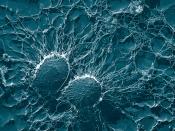This was originally written in Star Office and then copy and pasted office. The numbers seen must be put into a table to make sense. Other than that it is a good example for practical lab reports.
SUMATIVE PRACTICAL No.1
Organisms, Populations and Communities
Mark and Recapture
Introduction:
The Mark and Recapture method of estimating population size is used in the study of animal populations where individuals are highly mobile. It is of no value where animals do not move or move very little. The number of animals caught in each sample must be large enough to be valid. There is a simple formula used to find the approximate number of organisms in the area. This formula is:
No. of animals in 1st sample * No. of animals in 2nd sample
Total population = Number of marked animals recaptured
Using this simple technique you are able to gather an approximate number of organisms in the area.
Aim:
To use matches to simulate the mark and recapture method. We will use the mark and recapture method to estimate the counting of an organism population.
Hypothesis:
I feel that this practical will not accurately portray the mark and recapture method of counting population. I do not think that the sample we are to use is big enough for an accurate result. We are only using a box of matches which at most will contain 60 matches.
Materials:
Box of matches
Marker pen
Results:
Sample Number
1
2
3
4
5
Marked matches pulled from sample of 20
10*20 = 200
200/6 = 33
10*20 = 200
200/6 = 33
10*20 = 200
200/6 = 33
10*20 = 200
200/4 = 50
10*20 = 200
200/5 = 40
Sample Number
1
2
3
4
5
Estimated Population
33
33
33
50
40
Estimated population of matches:33+33+33+50+40
5
Estimated population of matches: 38
Actual number of matches: 36
Analysis:
The results from the practical were relatively accurate. The estimated number of matches differed only by 2 in comparison with the actual number of matches. By using 5 samples inaccuracies were evened out to make sure a relatively accurate number was given at the end. If only one or two samples were taken then you could gather a figure unusually high or unusually low.
To make sure that the samples were accurate four steps were taken. We marked the matches with highlighter, so that when selecting our matches we were not bias as we could not know which ones were marked, unlike if we marked them with tape or a tag. We mixed the marked matches back with the rest of the unmarked matches in a jar and shook the jar to make sure there was full integration. Then someone would pull matches from the jar while not looking in order not to make a bias selection. Finally five different samples were taken in order to gather a variety of answers.
There are some problems with the mark and recapture method of counting populations. If consequent sampling of the organisms is taken too soon after marking or re-counting then chances are the organisms have not had time to mix back into their habitat which means when they are recaptured you are given the indication that there are a lower number of organisms than what there really are. If subsequent samples are taken too long after marking or re-counting than there is a very high possibility that the organisms are dead or have moved to a different habitat. This gives the indication that there are more animals in the population that what there really are, as the calculation will be wrong.
There are assumptions made in this method of sampling that, if were not true, would cause the method to be inaccurate and fail. The method assumes that it is being used for a large population, not a small isolated population. If the population sampled was small and isolated than subsequent sampling would prove inaccurate. It also assumes that the animals move. If animals are sampled that do not move than you will get inaccurate results as you will be resampling the exact same animals in the same area. It also assumes that the animals stay in the one area all the time. If the animals migrate at all then later samples will prove inefficient as there will be none or few animals to recapture.
There are many animals that this method would be unsuitable for. They include migrating animals, stationary animals, territorial animals and humans. The method would not work with these kinds of organisms as they go against the assumptions that the method uses. The method assumes that the sampled animal is one that moves, interacts with others of its kind and stay in the one area all the time. The technique also assumes random mixing after tagging. If this does not happen then the results obtained will be inaccurate.
There are three main ways of marking animals for this method. Marking the animal with paint or some other marking device (pen, ink etc.) is the simplest method for marking organisms. However, it has many drawbacks. The mark may come off due to rain, water, or the organism shedding skin. Also, the marks may be confused with other natural marks on the animal, such as dirt and grime. Also the paint or ink may poison the animal causing death (an example of this is canetoads and paint).
Another method of marking organisms can be tagging them. This involves a tag with information being placed onto the animal at the time of capture. This is a good way of marking as more information can be put onto the animal than marking with ink or paint such as sample number and date collected. However, the tags can only carry limited information and may come off the animal from scratching or natural wear. This means that an animal may not be counted as being previously captured as it has no tag.
The third and most effective way of marking animals is with an electronic microchip. This is where a small microchip is placed under the animals skin and when scanned delivers information put on the chip. This method allows large amounts of data to be put onto the chip unlike normal tags. It is also harder for the tags to dislodge or fall off as they are secured under the animals skin, not connected to it like normal tags. However, this method would be ineffective for small animals such as small crabs and mollusks as the tags would be too big. It is also a very expensive way to mark animals and would be more suited for larger fish, mammals, reptiles and other large organisms.
Conclusion:
We used matches to simulate the mark and recapture method counting populations. The practical worked accurately which refuted our hypothesis. The sample number of matches was large enough to use as an example. We also overcame the problem of the marked matches integrating with the unmarked matches by mixing them together in a glass jar. The practical was an accurate example of the mark and recapture method of counting population.


